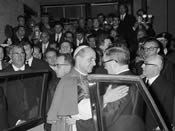The most popular or familiar scriptural reference to St. Joseph could be that found in the Gospel of St. Matthew, in which the husband of Mary is described as vir justus, “a just man” (Mt 1:19), meaning he had all the virtues. But there is a line in the Old Testament referring to the Joseph sold into slavery by his brothers, and who became ruler of Egypt (second to the Pharaoh), which can be taken as an invitation to have recourse to Joseph of Nazareth: Ite ad Joseph, “Go to Joseph”.
Ite ad Joseph et, quidquid vobis dixerit, facite, “Go to Joseph; what he says to you, do” (Gen 41:55). These are the words spoken by Pharaoh to the people who cried for food when famine gripped Egypt and the neighboring lands.
Like the Old Testament patriarch, the husband of Mary also had a “Jacob” for his father: “And Jacob begot Joseph, the husband of Mary, and of her was born Jesus who is called Christ” (Mt 1:16). Like Joseph who took care of the nation of Israel during the years of famine, Joseph of Nazareth is Patron of the Universal Church, the people of God. We would do well indeed always to “go to Joseph”, who is “the Master of the interior life” (The Forge, No. 554)—he worked facing God, his life spent contemplating Jesus in an intimate personal relationship—but even more in times of trouble or of our own spiritual dryness or darkness and crises.
Joseph of Nazareth is an example of grace building on nature or, conversely, human freedom corresponding with grace:
“The Holy Family remained in Egypt until Herod’s death (cf. Mt 2:14). But when Herod was dead, behold, an angel appeared in a dream to Joseph in Egypt, saying, ‘Arise, and take the child and his mother, and go into the land of Israel, for those who sought the child’s life are dead’ (Mt 2:19). This is what Joseph did. In the different circumstances of his life, Saint Joseph never refuses to think, never neglects his responsibilities. On the contrary, he puts his human experience at the service of the faith. When he returns from Egypt, ‘learning that Archelaus had succeeded his father Herod as ruler of Judaea, he was afraid to go there’ (Mt 2:22). In other words, he had learned to work within the divine plan.” (F. Fernandez, In Conversation with God, Vol. 6, No. 24.2; quoting St. Josemaria Escriva, Christ is passing by, No. 42)
“What is crucially important here is the sanctification of daily life, a sanctification which each person must acquire according to his or her own state, and one which can be promoted according to a model accessible to all people:
“‘Saint Joseph is the model of those humble ones that Christianity raises up to great destinies…he is the proof that in order to be a good and genuine follower of Christ, there is no need of great things—it is enough to have the common, simple and human virtues, but they need to be true and authentic’ [Paul VI, Address, 19 March 1969]” (F. Fernandez, op. cit., Vol. 6, No. 21.3; quoting John Paul II, Apostolic Exhortation, Redemptoris custos, 15 August 1989, No. 24).
“There are many good reasons to honor St. Joseph and to learn from his life. He was a man of strong faith. He earned a living for his family—Jesus and Mary—with his own hard work. He guarded the purity of the Blessed Virgin, who was his Spouse. And he respected—he loved!—God’s freedom, when God made his choice: not only his choice of Our Lady the Virgin as his Mother, but also his choice of St. Joseph as the Husband of Holy Mary” (The Forge, No. 552).
“Painters have traditonally depicted Joseph as an elderly man in order to emphasize the perpetual virginity of Mary. Yet it is more likely that Joseph was not much older than his wife. You don’t have to wait to be old or lifeless to practise the virtue of chastity. Purity comes from love; and the strength and joy of youth are no obstacle to a noble love. Joseph had a young heart and a young body when he married Mary, when he learned of the mystery of her divine motherhood, when he lived in her company respecting the integrity God wished to give the world as one more sign that he had come to share the life of his creatures.” (F. Fernandez, op. cit., Vol. 6, No. 22.2; quoting St. Josemaria Escriva, Christ is passing by, No. 40).
While it is from Mary that our Lord Jesus Christ takes the substance of His Sacred Humanity, much of the formal (and legal), and somehow, essential, aspect of Jesus’ identity comes from Joseph.
Our Lord was known as the son of Joseph: “Is not this the carpenter’s son?” (Mt 13:55); “Is not this the carpenter, the son of Mary?” (Mk 6:3); “Is not this Joseph’s son?” (Lk 4:22). It is through Joseph, “because he was of the house and family of David” (Lk 2:4), that the promise of the Messiah as a descendant of King David is fulfilled.
Let us always go to Joseph: “St. Joseph, our father and lord: most chaste, most pure. You were found worthy to carry the Child Jesus in your arms, to wash him, to hug him. Teach us to get to know God, and to be pure, worthy of being other Christs.” (The Forge, No. 553)
O.C.P.A.J.P.M.








